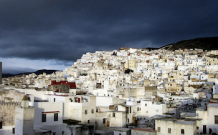Tetouan, Morocco’s Little Jerusalem
 |
| Tetouan Medina, Little Jerusalem |
Numerous families in Tetuoan still keep their Spanish last names. Voyagers keen on investigating Tetouan on a one-day visit can do as such from Tanger Med or the Port of Tangier while showing up by journey transpoart.
Tetouan is fondly nicknamed the White Dove, Little Jerusalem and most symbolically, the Daughter of Granada.
The city of Tetouan is all around arranged in the North of Morocco, along the Mediterranean Sea, and is one of the simplest section focuses into Europe. Tetouan has truly been the area most affected by the Spanish. The French protectorate was set up in 1912 with the Treaty of Fez, and was regarded all through the vast majority of Morocco except for Tangier. The area of Northern Morocco was set under Spanish space in the 1912 arrangement set up among France and Spain and after a year Francisco Franco made Tetouan his home office.
In spite of the fact that Tetouan was initially a Roman settlement of Tamuda, occupied by the Idrisid tradition in the ninth century and the Marinid line in the 1492, the Moorish Andalusian evacuees populated Tetouan after the Reconquista. There was a great deal of hybrid between the Moors from Morocco and Spain, even the name Andalucia originates from the Arabic word, El Andaluz. During the 1860s, the Spanish authoritatively denoted their region on Morocco when Spanish soldiers caught Tetouan.
The nearness of Northern Morocco to Spain has additionally assumed a job in making an area of Morocco with clear signs the Spanish were there. This can be found in structure, food, and engineering all through Morocco's Northern urban areas of Tangier, Tetouan, and Chefchaouen. It is Tetouan, in any case, found 60 kilometers south of Tangier, that has the most unmistakable Andalusian engineering and culture.
 |
| Tetouan Spanish Influences in Signage & Architecture |
The Tetouan of today is still said to retain it’s Spanish influence.
Mohammed Ave is the identical representation of a white washed Andalucian road from Seville or Granada – a congregation, librerias, pastelerias selling milo de flores, tapa bars serving bocadillas, lofts with galleries hanging clothing, the Spanish Institute El Cervantes, and the Spanish Consulate would all be able to be found on Mohammed Avenue and encompassing boulevards.
Tetuoan's Kasbah is situated in what is supposed to be Morocco's littlest medina, anyway the five kilometers of old noteworthy divider are considered the most aesthetic and enchanting all through Morocco. Tetouan is seemingly Morocco's most significant workmanship place. Throughout the hundreds of years, Ottman,
Rifean, and European impacts undulated through the city.
Tetouan was also a trading town, intellectual center, and place for the establishment of commercial and artisan work, especially mosques and zaouïas.
It is famous for the school of arts and crafts (Dar Sanaa) and its National Institute of Fine Arts. The city of Tetouan has 7 famous gates historically used as orientation markers to pilgrimage to nearby towns like Cueta, today they are useful to orientate yourself in the medina and discover the traces of Little Spain in Tetouan: Spanish style wrought iron gates, names of streets written in Spanish, and Spanish eateries.
 |
| Synagogue in Tetouan, Jewish Mellah |
A Tetouan Guided Tour of this UNESCO City:
• Morning takeoff from your lodging in Tangier or the Tangier Port.
• Begin your Tetouan visit with a visit to the Big Mosque, the Spanish Cathedral, Babu Saidi, the Kasbah, the Medina, and Hassan II Square. At that point visit the old Royal Palace, a seventeenth century working, at Place Hassan II. Hassan II Square is an impression of the Hispano-Moresque engineering of Tetouan. The castle is shut to open section yet its fundamental luxurious door Bab Er-Rouah is eminent. Spot Hassan II, where the old and new town meet, is the dynamic heart of Tetouan.
• Next, investigate Tetouan's old medina, an UNESCO World Heritage site. The old medina in Tetouan was previously a privateer center point and the capital of Spain during pioneer times. The Romans annihilated Tetouan and it was repopulated in the sixteenth century. Tetouan was an asylum for Jews, Moors, and Moriscos who got away from the Spanish examination and numerous individuals in the city despite everything communicate in Spanish.
• Lunch in Tetouan of neighborhood Moroccan passage and afterward investigate Tetouan's winding roads and back streets on your way to the fortress.
• Visit the Jewish mellah, the Berber showcase, and the Andalusian segment. The Jews of Tetouan once lived in its mellah that was isolated from the remainder of the town by entryways that were shut around evening time. Tetouan was once home to a significant Sephardic Jewish people group, which moved from Spain after the Reconquista and the Spanish Inquisition. This Jewish Sephardic people group talked a type of Judeo-Spanish known as Haketia. There are not many Jews left in Tetouan today. Alternative to investigate the Jewish place of worship and burial ground.
• End the day with a visit of Tetouan Archeology Museum with curated displays of Roman relics, ancient rarities, and mosaics from Lixus.
• Return to your lodging or the Tangier Port
Commentaires
Enregistrer un commentaire